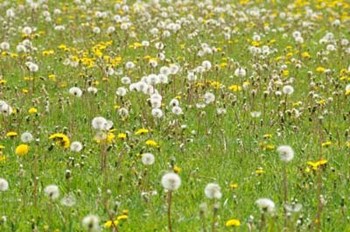
While South Floridians do not have to brave the chilly, barren winters of more northerly environs, in many respects it’s more difficult to maintain a lush lawn year-round than it is to plant more seasonally in a varied climate. Challenging or not however, keeping your grounds healthy, lush, and well-maintained is crucial to maintaining curb appeal and value—so it therefore becomes a critical issue for all associations to address.
Green Year-Round
“In Florida, we have the type of climate where problems such as pests and disease happen year round—whereas in northern states, they really don’t have these issues half the year,” says Michael Sacco, operations manager for the Lighthouse Point-based Empire Services Group. “Proper watering for the time of the year, how well drained your soil is and sun exposure is also very important.”
For many associations, the first question that arises is whether to hire an outside contractor to perform landscaping duties or use an in-house maintenance or staff to handle this all-important task. The fact is, there's more to cultivating healthy lawns than just sprinkling some grass seed, turning a hose on it for a few minutes, and letting nature take its course.
Sacco says that the blunder of planting the “wrong plant in the wrong location” goes for grass as well as other items like shrubs or flowers. Depending on a particular species' ideal growing conditions, it may not “like” a certain type of soil; it may be too acidic or alkaline, or too thick with nutrients and dirt causing root rot, which can ultimately kill a plant—including grass. It is for these reasons that Jeremy Smith, owner of Palm Beach-based Diamond Cuts Landscaping recommends using outside contractors to conduct this type of work, rather than opting to have in-house maintenance or grounds staff carry out lawn care.
Regardless of who handles this all-important responsibility however, Smith says there are protocols to follow. “Proper irrigation practices are most important,” he says, “followed by fertilization treatments two or three times per year and keeping an eye out for invasive pests, such as chinch bugs and grubs.”
And since Southern Florida is almost always warm with the highest amount of precipitation in June and the hottest month in August, it is difficult to apply standards to maintenance cycles. “There is no specific month to perform certain tasks in South Florida because there’s a need for constant proper maintenance,” says Smith. “But it’s a good idea to apply weed and feed to the turf in the spring and fall months.”
Sacco agrees with Smith, adding that associations and condos likely don't have the deep pockets of large commercial properties (such as hotels, for example) who can afford to maintain a full on-site landscaping staff all year. “Companies like the Marriott...have professionals working in-house to maintain a picture perfect property,” he says. “Most of the time an association will have a contractor take care of the lawn and landscape to alleviate the headache and overhead of maintaining larger properties.”
Florida Growth
According to Sacco, South Florida’s climate—while great for vacationing or retirement—is also attractive to unwanted invasive plant and animal species. These include species like Florida holly, Boston ferns and Mexican petunia. “Some of these are very pretty,” says Sacco, “but they will quickly take over large areas and plant beds if not maintained properly.” With regard to weeds that can choke a lawn into scraggly submission, the list is longer. “Some common weeds include ground ivy, dog fennel, crabgrass, dollar weeds and veronica.”
Smith says common lawn weeds he encounters are Florida pusley and crabgrass, and that “Crabgrass can be avoided with the application of pre-emergent chemicals such as Weed-and-Feed in the spring. If you see crabgrass in the turf, the best method is to just pull it out by hand. If it’s a large area, it would have to be sprayed with a weed killer and new sodding would likely be needed.” He adds that an even bigger headache are the nuisance vines that invade plants and tangle up in hedges, and “must be pulled out from the roots” in order to be truly eradicated.
When these unwanted species are left unchecked, they can quickly takeover plant beds, hedges and grass. According to Sacco, ridding an association's landscape of intruders is cumbersome and difficult. “If the area is 60 percent grass and 40 percent weeds or worse, it can sometimes take a few years to reclaim that area with grass,” he says. “At that point, I would scalp out the area and replace it with sod to take care of the situation immediately.” If the invaders aren't so entrenched, “You would treat the grass with a weed killer and grass fertilizer at certain times of the year to kill out the weeds and make the grass spread and fill in those areas quicker without the weeds coming back.”
Chemical Balance
Historically, potent chemicals were used to combat unwanted growth such as weeds, crabgrass and nuisance plants, but many of these were deemed unsafe for both people and the environment, and subsequent legislation outlawed the use of many. In recent years, there has been a movement toward organic remedies, although certain approved chemicals are still administered.
“We use a commercial grade weed killer from a few suppliers we know and trust to kill off weeds in plant beds,” says Sacco. “We never use residential grade from [big box] stores because [with our suppliers] we know we are getting a product from people who make it their lives to eradicate weeds in the most efficient, most environmentally friendly way possible.”
Sacco further points out that most weed killers are by their nature toxic, and that “Any one of them can be hazardous if the applicator is not experienced, or doesn't apply the recommended amount according to the manufacturer.” Aside from possible consequences to residents, pets, and the surrounding ecosystem, overuse of herbicides or insecticides can kill the very grass they were intended to protect.
In order to prevent health hazards and environmental damage, “In 2014 all landscape companies who apply fertilizer and weed killers will be required to have the proper training and license to do so,” says Sacco, adding that his firm made sure their licensure was in place in 2013. Industry experts note that there are non-chemical herbicides such as corn gluten meal and citric acid based products that have been proven to be effective; however, these products do tend to be more expensive than old-school remedies.
While early due diligence can be effective in thwarting unwanted growth such as crabgrass, transitional areas such as edges where a lawn meets the paved surfaces can be challenging. In these spots of compacted turf, crabgrass can—and will—often persist, even if pre-emergence applications are made.
Landscape Investments
There are organizations that boards can turn to for guidance. For example, the Florida Landscape Management Association (FLMA)’s website states: “Your lawn service contractor should possess a good working knowledge of turfgrass, plants, insect and disease problems, environmental laws, materials, supplies, equipment and methods to do a quality job. Ask what training they’ve had and what certifications they hold.”
When vetting a landscape company, the Association recommends that contractors be a member of one or more of the following organizations: the FLMA, the Florida Turfgrass Association (FTGA), Florida Nurserymen and Growers Association (FNGLA) and the Florida Pest Control Association (FPCA).
The amount of money an association invests in keeping a respective property healthy and aesthetically pleasing depends on a numerous factors. These include the size of the property, as well as the types of trees, plants, shrubs, flowers and bushes that populate the property. As a result, investment amounts will vary. According to the Environmental Protection Agency (EPA), the average 1-acre lawn cost is approximately $700 and requires 40 hours of labor each year to maintain. However, this metric is more so a guide for pricing, explains Smith.
“It’s difficult to estimate costs,” says Smith. “Every property and job is different and there’s not a one size fits all price formula. But it helps to be working with a knowledgeable company that can avoid extra repair/replacement costs with proper maintenance.”
Sacco finds the EPA purported average slightly misleading. “You really cannot put a cost on a vague question such as this, because this all depends on the size of the property and the condition it's in,” he says. “Also, if the community has monuments that require new planting of annuals every year, or if for example they had fungal issues, pests, weed issues. There are a lot of factors that go into the general cost to maintain each particular property.”
To provide greater context, Sacco offers an example. He says if a board were to use the provided EPA ratio to price a 200-acre property, they would likely arrive at the wrong estimate. “When you have a larger area, you still are making the same trip and cost in fuel - and as far as material goes, if you need more, the cost goes down a little bit for buying large amounts,” he continues. “So, if you use the average cost of a one-acre lawn to average the cost of the 200-acre site, [the larger property] would roughly be 18 percent cheaper. Again, it all depends on the condition of the site.”
Landscaping Takeaways
Whether an association hires an outside contractor or allows the management company to handle landscaping duties, there are industry protocols underscoring best practices. To this end, Florida Landscape Management Association recommends asking for recommendations as well as licenses, certifications and insurance from vendors. In addition, contractors should be queried about the education and training of supervisors and crew members as well as the number of Certified Landscape Maintenance Operators (CLMO) they have on staff. “You want to ask in-depth questions about their technical and business know-how,” the website states.
In the final analysis, and in Sacco’s experience, while boards are charged with this important decision, they usually make the right call. “Generally the association appointed to make the decisions of the community as a whole is responsible for maintaining all aspects of the community including maintenance, taxes, remodeling, budgets and insurance,” he continues. “A board is usually appointed to make decisions based on information given by vendors and ultimately when a decision is met the board president and property manager will sign off on the services via contract.”
W.B. King is a freelance writer and a frequent contributor to The South Florida Cooperator.




Leave a Comment